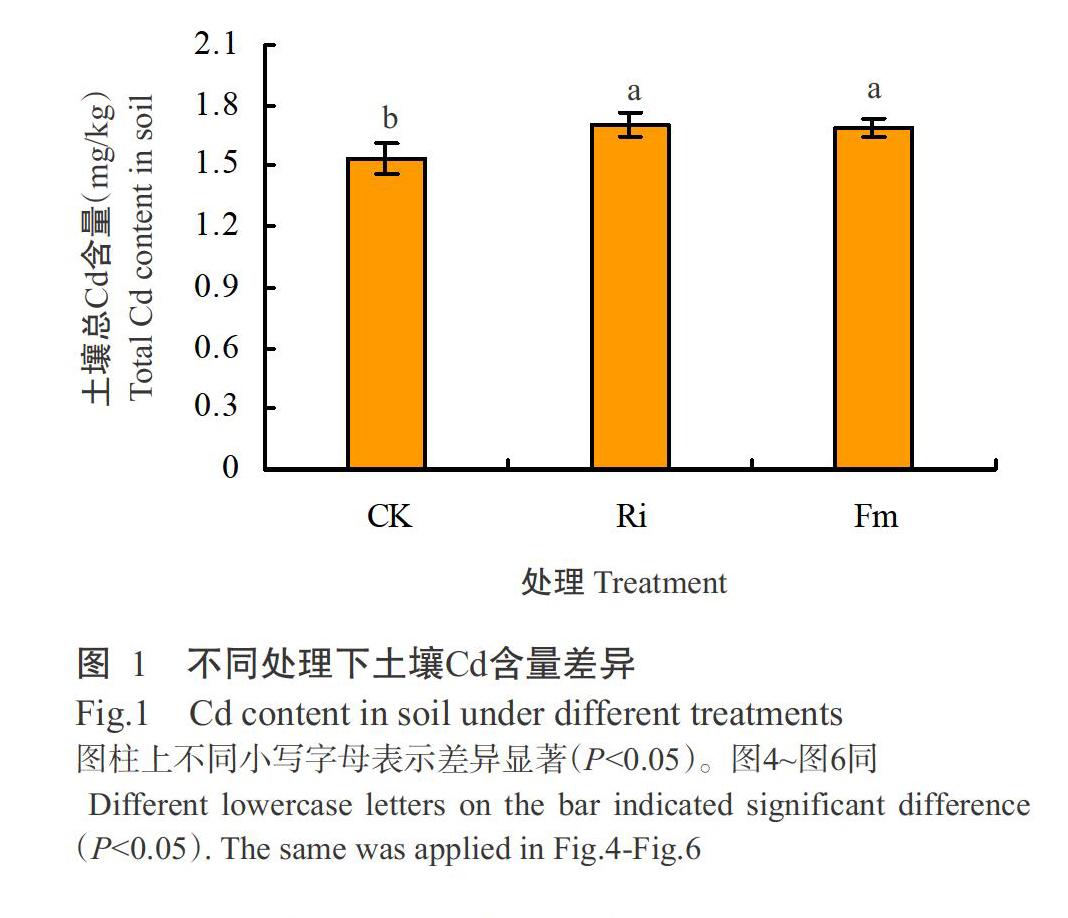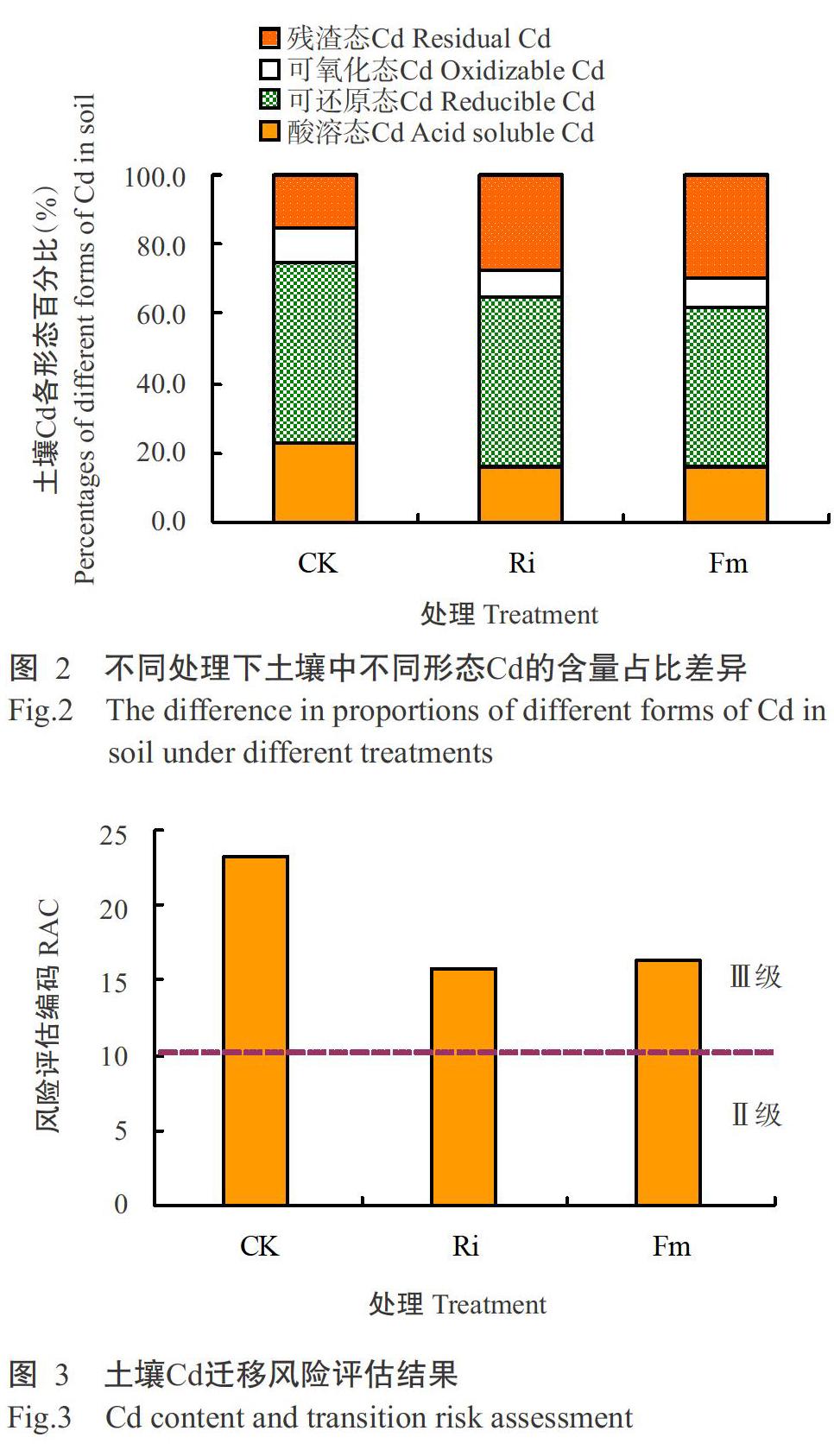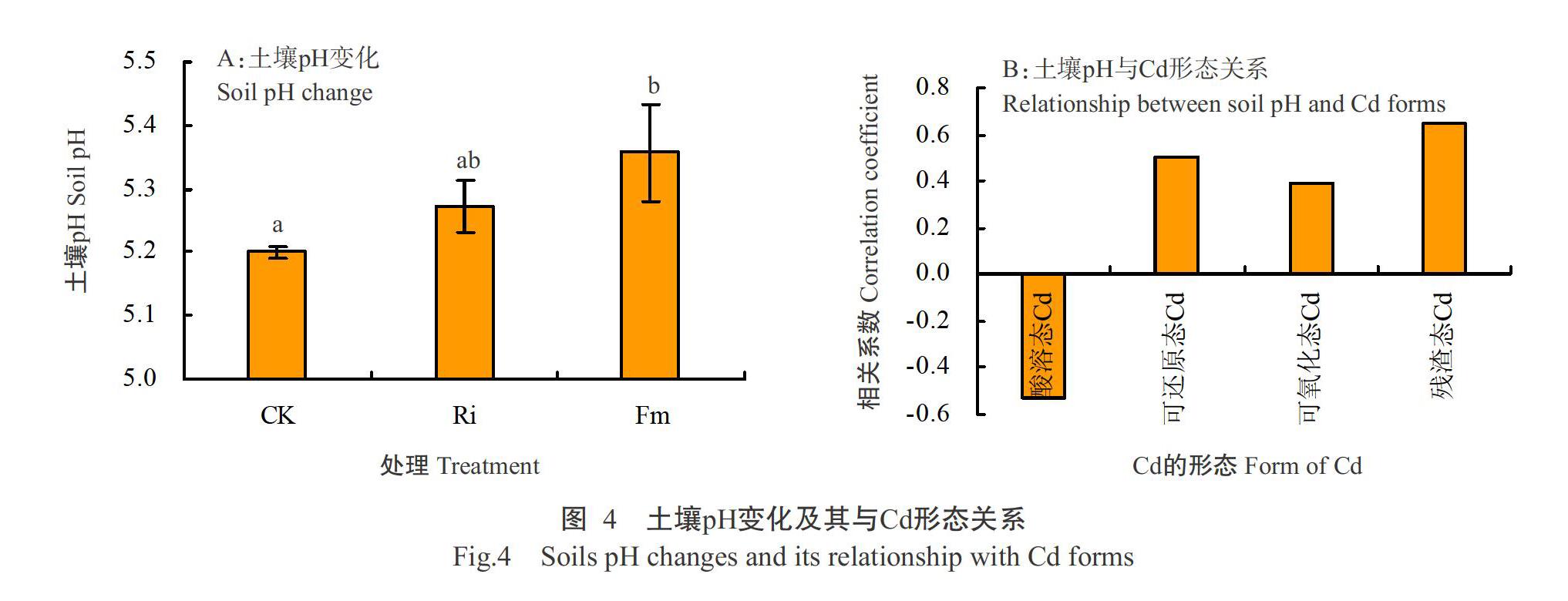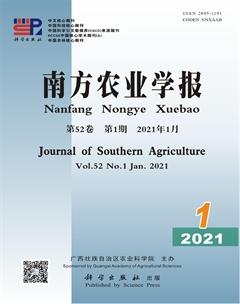接种丛枝菌根真菌对辣椒积累转运镉的影响
牟玉梅 邢丹 周鹏 宋拉拉 吴康云 胡明文 盖霞普



摘要:【目的】明确丛枝菌根真菌对辣椒植株积累转运镉(Cd)的影响,为阻控Cd向辣椒植株地上部转移和植物修复的应用提供参考依据。【方法】采用盆栽试验,以辣研201为试材,对其接种根内根生囊霉(Rhizophagus intraradices)和摩西管柄囊霉(Funneliformis mosseae),比较接种与未接种的土壤、辣椒根系与地上部Cd含量变化,从而探究接种根内根生囊霉和摩西管柄囊霉对辣椒植株积累转运Cd的影响。【结果】与来接种处理相比,接种根内根生囊霉和摩西管柄囊霉后土壤中Cd总量显著提高10.80%和9.98%(P<0.05,下同),土壤中Cd各形态含量占比发生变化,残渣态Cd含量提高79.82%和95.44%,而酸溶态Cd含量占比的迁移风险降低32.19%和29.45%。接种Ri和Fm后辣椒根系Cd含量分别显著增加39.57%和53.13%,根系富集系数显著分别提高33.15%和40.68%;而地上部Cd含量分别降低15.02%和9.30%,地上部富集系數分别显著降低24.35%和18.91%;辣椒体内Cd转运系数分别显著下降30.15%和33.72%。基于典型相关分析可知,典型权重较大的残渣态Cd含量对土壤Cd含量变化起正向作用,辣椒根系Cd富集系数与体内Cd转运系数对辣椒Cd含量变化起反向作用;基于典型载荷与交叉载荷分析可知,土壤中酸溶态Cd低则移除程度弱、残渣态Cd高则滞留程度强,因而辣椒积累转运Cd能力差。【结论】接种从枝菌根真菌可调控辣椒地上部与根系间Cd的分配,一定程度上可控制土壤中的Cd由根部向地上部转移。
关键词: 辣椒;丛枝菌根真菌;镉;富集能力;转运能力
中图分类号: S641.3 文献标志码: A 文章编号:2095-1191(2021)01-0172-08
Abstract:【Objective】To investigate the effects of arbuscular mycorrhizal fungi on cadmium(Cd) accumulation and transport in Capsicum annum L.(pepper), so as to provide reference for the application of preventing Cd transfer to the above-ground part of pepper and phytoremediation. 【Method】The experiment was carried out with Layan 201 as the material and planted in pot, pepper was inoculated Rhizophagus intraradices and Funneliformis mosseae respectively. Analyzed the variation of Cd content in soil with and without inoculation, pepper root and aboveground part, and explored and discussed the effects of inoculating R. intraradices and F. mosseae on accumulation and transport Cd in pepper. 【Result】Compared with the non-inoculation treatment, the total content of Cd in soil with the R. intraradices and F. mosseae inoculated significantly increased by 10.80% and 9.98%(P<0.05, the same below), and the proportion of Cd in different forms in soil changed. The residual Cd increased by 79.82% and 95.44%. While, with regard of the proportion of acid-so-luble Cd, the migration risk decreased by 32.19% and 29.45%. With R. intraradices and F. mosseae inoculated in soil, Cd content in the root system increased by 39.57% and 53.13%, and Cd enrichment coefficient in the root system increased by 33.15% and 40.68%, while Cd content in the aboveground part decreased by 15.02% and 9.30%. Cd enrichment coefficient in the aboveground part decreased by 24.35% and 18.91% and Cd transport coefficient in pepper body decreased by 30.15% and 33.72%. Based on canonical correlation analysis, residual state Cd with a large typical weight had a positive effect on the change of Cd content in soil, and Cd enrichment coefficient in root and Cd transport coefficient in pepper had negative effect on the change of Cd content. For the analysis of typical loading and cross loading, Cd in low acid- so-luble state in soil resulted in weak removal degree, while Cd in high residual state resulted in strong retention degree, so pepper had poor ability to accumulate and transfer Cd. 【Conclusion】The distribution of Cd between aboveground part and root of pepper is controlled by inoculation of mycorrhizal fungi, and it can inhibit the transfer of Cd in soil from root to aboveground part.
徐笠,陸安祥,田晓琴,何洪巨,殷敬伟. 2017. 典型设施蔬菜基地重金属的累积特征及风险评估[J]. 中国农业科学,50(21): 4149-4158. [Xu L,Lu A X,Tian X Q,He H J,Yin J W. 2017. Accumulation characteristics and risk assessment of heavy metals in typical greenhouse vegetable bases[J]. Scientia Agricultura Sinica,50(21): 4149-4158.]
张文丽,姚丹成,孙嘉龙,韩京秀,尚琪. 2015. 贵州省赫章县镉污染区人群健康损害状况调查及损害指标关系探讨[J]. 卫生研究,44(5):780-787. [Zhang W L,Yao D C,Sun J L,Han J X,Shang Q. 2015. Survey on the status of health effects and relationship between indices of health effects of population in environment cadmium po-lluted area in Hezhang County,Guizhou Province[J]. Journal of Hygiene Research,44(5):780-787.]
Aloui A,Recorbet G,Gollotte A,Robert F,Valot B,Gianina-zzi-Pearson V,Aschi-Smiti S,Dumas-Gaudot E. 2009. On the mechanisms of cadmium stress alleviation in Medicago truncatula by arbuscular mycorrhizal symbiosis:A root proteomic study[J]. Proteomics,9(2):420-433.
Bissonnette L,St-Arnaud M,Labrecque M. 2010. Phytoextraction of heavy metals by two Salicaceae clones in symbiosis with arbuscular mycorrhizal fungi during the second year of a field trial[J]. Plant and Soil,332:55-67
Chaturvedi R,Favas P,Pratas J,Varun M,Paul M S. 2018. Assessment of edibility and effect of arbuscular mycorrhizal fungi on Solanum melongena L. grown under heavy metal(loid) contaminated soil[J]. Ecotoxicology and Environmental Safety,148:318-326.
Chen B D,Liu Y,Shen H,Li X L,Christie P. 2004. Uptake of cadmium from an experimentally contaminated calca-reous soil by arbuscular mycorrhizal maize(Zea mays L.)[J]. Mycorrhiza,14:347-354.
Coninx L,Martinova V,Rineau F. 2017. Mycorrhiza-assisted phytoremediation[J]. Advances in Botanical Research,83:127-188.
González-Chávez M C,Carrillo-González R,Wright S F,Ni-chols K A. 2004. The role of glomalin,a protein produced by arbuscular mycorrhizal fungi,in sequestering potentially toxic elements[J]. Environmental Pollution,130(3):317-323.
Hassan S E,Hijri M,St-Arnaud M. 2013. Effect of arbuscular mycorrhizal fungi on trace metal uptake by sunflfl ower plants grown on cadmium contaminated soil[J]. New Biotechnology,30(6): 780-787.
Hu J L,Tsang W,Wu F Y,Wu S C,Wang J H,Lin X G,Wong M H. 2016. Arbuscular mycorrhizal fungi optimize the acquisition and translocation of Cd and P by cucumber(Cucumis sativus L.) plant cultivated on a Cd-conta-minated soil[J]. Journal of Soils and Sediments,16:2195-2202.
Joner E J,Briones R,Leyval C. 2000. Metal-binding capacity of arbuscular mycorrhizal mycelium[J]. Plant and Soil,226:227-234.
Koide R T,Mosse B. 2004. A history of research on arbuscular mycorrhiza[J]. Mycorrhiza,14:145-163.
Kuga Y,Zhang X,Wu S L,Ohtomo R. 2018. Uptake and intra-radical immobilization of cadmium by arbuscular mycorrhizal fungi as revealed by a stable isotope tracer and synchrotron radiation μX-ray fluorescence analysis[J]. Microbes and Environments,33(3):257-263.
Liu Y Z,Xiao T F,Baveye P C,Zhu J M,Ning Z P,Li H J. 2015. Potential health risk in areas with high naturally-occurring cadmium background in southwestern China[J]. Ecotoxicology and Environmental Safety,112:122-131.
Mnasri M,Janou?ková M,Rydlová J,Abdelly C,Ghnaya T. 2017. Comparison of arbuscular mycorrhizal fungal effects on the heavy metal uptake of a host and a non-host plant species in contact with extraradical mycelial network[J]. Chemosphere,171:476-484.
Repetto O,Corre G B,Dumas-Gaudot E,Berta G,Gianinazzi-Pearson V,Gianinazzi S. 2003. Targeted proteomics to identify cadmium-induced protein modifications in Glomus mosseae-inoculated pea roots[J]. New Phytologist,157(3):555-567.
Wang F Y,Shi Z Y,Xu X F,Wang X G,Li Y J. 2013. Contribution of AM inoculation and cattle manure to lead and cadmium hytoremediation by tobacco plants[J]. Environmental Science:Processes & Impacts. doi:10.1039/c3em3 0937a.
Xin J L,Huang B F,Liu A Q,Zhou W J,Liao K B. 2013. Identification of hot pepper cultivars containing low Cd levels after growing on contaminated soil:Uptake and redistribution to the edible plant parts[J]. Plant and Soil,373:415-425.
Zhang X Y,Chen D M,Zhong T Y,Zhang X M,Cheng M,Li X H. 2015. Assessment of cadmium(Cd) concentration in arable soil in China[J]. Environmental Science and Pollution Research,22: 4932-4941.
(責任编辑 邓慧灵)

